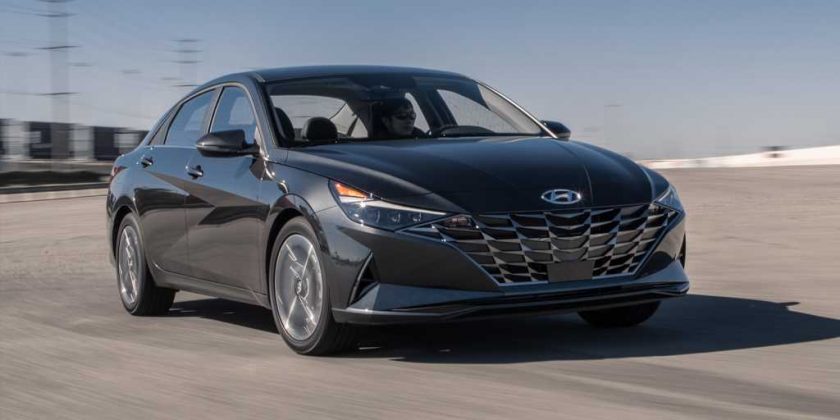Historically, the Hyundai Elantra wasn’t the most stylish or fun to drive offering in its segment. Need proof? Take a look at this story tracking the Elantra’s progress as we reviewed each subsequent generation. By the 2011 model year, its design and driving capabilities began to stand out. Now, we’ve gotten our hands on the seventh-generation 2021 Hyundai Elantra. We evaluated it on the street and on our test track to see if its capabilities measure up to its bold new styling.
Segment Stalwart
Our test Elantra arrived at the office equipped at the Limited trim level wearing a price tag of $26,610. It wore sparkling Portofino Gray paint and attractive 17-inch wheels. It looks sharp and certainly stands out from the average compact sedan thanks to its sharp lines and flamboyant “catfish” grille. This last point is probably the most contentious accent to be found on the Elantra, but we suppose it’s better to be bold than be basic.
A 2.0-liter I-4 sends 147 hp and 132 lb-ft to the front wheels by way of a CVT. Around town, the powertrain is smooth and hardly noticeable when the music’s playing. Under full-throttle acceleration, the Elantra doesn’t get too buzzy or coarse. Simulated shifts from the CVT are inoffensive. In fact, the transmission is so smooth, it takes a back seat to the car’s otherwise admirable poise.
At the test tract, the 2021 Elantra managed a 0-60-mph time of 8.4 seconds. For comparison, a 2020 Toyota Corolla XSE eked out an 8.2-second run, and a Honda Civic Sport Touring managed a relatively blistering 7.1-second launch. What it lacks in briskness, the Hyundai Elantra makes up in braking. We noted that the stoppers have excellent bite and exhibit very little fade after numerous tests. Slowing from 60 to 0 mph took 116 feet to the Toyota Corolla’s 119 feet. The Civic Touring managed just 113 feet to do the same.
The Elantra’s steering can be a bit vague around center, but activating Sport mode firms it up. Road test editor Chris Walton noted, “Steering is a bit lifeless, but it’s easy to make midcorner directions.” After nearly two weeks behind the wheel, one becomes accustomed to the steering feel, and although it isn’t as sharp as we’d like, the driver doesn’t have to fight the Elantra to get it to go the correct direction. Walton commended the Elantra’s tenacious grip on the skidpad. We recorded an average of 0.85 g of lateral grip. Not bad for an economy sedan riding on all-season tires, though that Civic hatch managed 0.90g on its all-seasons.
Our test editors didn’t detect much of an advantage to using Sport mode at wide-open throttle. At this trim level, the Elantra Limited’s selector button is mounted up and to the left of the shifter. However, to the left of the instrument cluster, there’s an illuminated circular motif that serves no purpose. On the Elantra N-Line, this is where the drive mode selector is situated.
Budget Luxury
In another time, getting assigned a Hyundai Elantra review would be a chore. Historically, the South Korean compact wasn’t the most stylish or fun to drive offering in its segment. Much of that has changed now. The bodywork’s sharp lines appear upscale, and the interior, at least in Limited trim, is covered in a pseudo leather that feels both comfortable and durable. Most surfaces the driver commonly touches, like the door inlays and armrests, are covered with the stuff.
The cabin feels stylish and premium, too—thanks to dual 10.3-inch screens that recall the cockpit of a Mercedes-Benz product. They’re lightning-quick and display sharp graphics, too. Apple CarPlay and Android Auto connectivity work without hang-ups. The user experience is very intuitive, with controls laid out in a way that renders features easy to find. Hyundai’s new four-spoke steering wheel is both attractive and feels great in the driver’s hands. The controls are easy to use and nonintrusive, preventing accidental inputs.
Back-seat room is plentiful for adults, and trunk space is abundant. The interior isn’t claustrophobic and even feels airy with the sunroof open—just like the inside of a well-designed luxury car. Only when your hand goes astray and thwacks into hard plastic does the illusion of the high life dissipate. In particular, the cupholders come to mind. Hyundai made them height adjustable (the bottom can be removed and flipped over to make the cupholders deep or shallow), but there’s nothing to hold bottles or cups still. Tall Swell brand bottles rattle and flop around, for example, to an extraordinarily irritating effect. If there’s any place to add padding, it’s here.
Hyundai equipped the Elantra Limited with an impressive array of high-tech features. Keyless entry and remote start came equipped on our test car. The Elantra Limited sorely lacked parking sensors, an odd exclusion when it even featured safety functions like automatic collision alert and prevention and rear cross-traffic collision-avoidance assist, in addition to a bevy of safety technology. That being said, it does have an electric parking brake and auto hold, two features that aren’t guaranteed to be included on cars twice or three times this price. Drivers also benefit from wireless charging and a sonorous eight-speaker Bose premium audio system.
Verdict
Once an underdog, the Elantra has taken on a much more confident and coherent identity. Starting at $19,650, Hyundai’s compact sedan is feature rich and presented in a well-designed package. It drives with poise and manages to be comfortable, as well. We value the fulfillment of purpose, and the Elantra Limited has done just that. Underdog no more, this truly is a vehicle worthy of your consideration.
Source: Read Full Article
